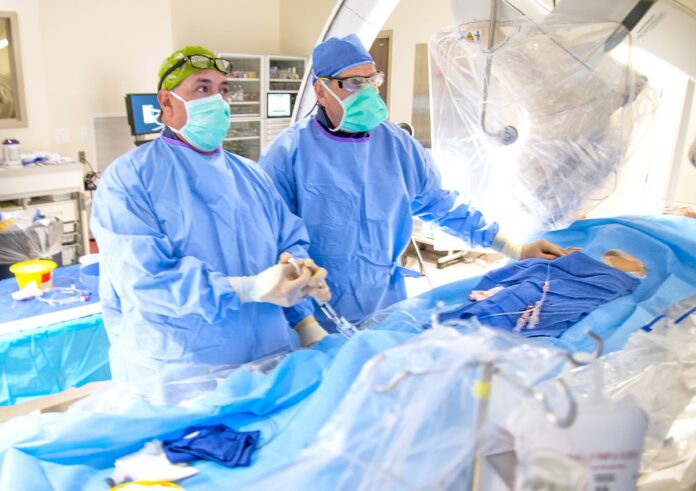HARLINGEN — Gary Bordelon lay sedated on the table, images of his pumping heart playing on a screen.
“This is a sheath,” said cardiologist Dr. Charles Mild as he slipped the tubular instrument into an opening in Bordelon’s groin. Once in place, a catheter was slipped through the sheath into major arteries going to his heart.
This being American Heart Month, it seems only fitting that Bordelon was the first patient to receive a diagnostic angiogram on Valley Baptist Medical Center’s new Biplane Angiographic Suite.
The new machine takes pictures from two different directions instead of one. Two pictures instead of one provide more information for diagnosis and treatment.
This in turn requires fewer pictures to be taken, which reduces the time for the whole procedure. It uses less radiation and is therefore safer for both patients and medical personnel.
Furthermore, less contrast fluid is used, and that makes it easier on the kidneys. The new biplane makes an angiogram safer, simpler, and quicker.
The X-ray tubes of the new state-of-the-art machine whirred quietly Friday as they rotated around Bordelon’s chest, one from the side and another from the top. Image intensifiers magnified and processed the X-rays as the tubes shot 30 frames per second.
“Now put in some contrast,” Mild said to Omar Davila, a cardiovascular technician who was decked out in scrubs and protective lead coat.
Davila injected a contrast liquid through the catheter to illuminate parts of the heart as the X-ray tubes took pictures. The catheter could easily be seen on the screen releasing contrast fluid into the heart.
Contrast fluid is a chemical used to make parts of the heart visible in an X-ray. It’s hard on the kidneys, so the less contrast, the better.
“We’ve got some problems here,” Mild said, viewing the screen. “We can’t see from this view, that’s why we have to get another view.”
And that right there, another point of view, is why the new biplane is a key addition to Valley Baptist Medical Center – Harlingen. The hospital has three of the new biplanes. They can take pictures from two different directions, giving multiple points of view, resulting in a broader perspective.
Such a broader viewpoint of any situation is powerful. In this case, it reduces the time necessary for the same amount of pictures — and the danger.
“If we didn’t have the biplane we’d have to take eight separate pictures with eight separate contrast injections,” Mild said. “With the biplane, we get two pictures with every contrast injection. So it limits the amount of contrast by 50 percent.”
CONTRASTING
Actually, the amount of contrast savings can be even more, making it even easier on the kidneys.
“Sometimes when you get these double pictures you get so much more information you don’t have to take another picture,” he said.
Contrast, he said, is necessary to get pictures, but it’s also toxic for the kidneys. Less contrast, less toxicity, he said.
The machine used for the heart is smaller than those used for the brain and more maneuverable.
“Since the heart moves, we have to move around it to see all the positions,” Mild said. “It reduces the dosage of the X-ray we need and all the X-ray goes directly to the heart, nowhere else.”
Biplanes used for procedures on the brain are a little bigger because they must go through more bone.
“For the heart we don’t have to go through a lot of bone,” he said. “So why use all this extra X-ray that’s toxic to the body if you don’t need to? So we’ve got this new lab dedicated for hearts only.”
He added though that all three labs are multi-purpose.
The procedure on Bordelon went smoothly and quickly. The table on which Bordelon lay moved back and forth and Mild asked, “Ready?”
The cameras shifted and Mild explained, “This is the camera we use to take pictures of the heart’s movements.”
The procedure only took about 20 minutes, typical for a diagnostic procedure. Bordelon had suffered a heart attack, so Mild had expected more problems than he found.
“He did have some blockage but not to the point we need to do surgery,” Mild said. “He doesn’t need angioplasty. A decision was made he was a candidate for strictly medical management. He’s a lucky man.”
Down the hall, the next patient waited for his own angiogram. Doctors planned to run the catheter through the arm of Vidal Castro, who’d experienced some shortness of breath recently. He appreciated the fact the procedure would be simpler and quicker, and he’d get results the same day.
“It helps, people want to do it faster,” said Vidal, 42, of Raymondville.
His wife San Juanita Gallardo was also grateful.
“He will know right away then what’s wrong,” she said. “The doctor will be there.”





